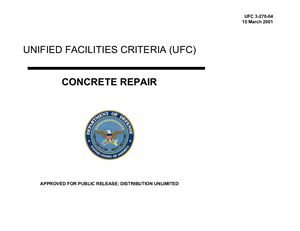2001 г. 99 с.
The Unified Facilities Criteria (UFC) system is prescribed by MIL-STD 3007 and provides
planning, design, construction, sustainment, restoration, and modeization criteria, and applies
to the Military Departments, the Defense Agencies, and the DoD Field Activities in accordance
with USD(AT&L) Memorandum dated 29 May 2002. UFC will be used for all DoD projects and
work for other customers where appropriate. All construction outside of the United States is
also goveed by Status of forces Agreements (SOFA), Host Nation Funded Construction
Agreements (HNFA), and in some instances, Bilateral Infrastructure Agreements (BIA.)
Therefore, the acquisition team must ensure compliance with the more stringent of the UFC, the
SOFA, the HNFA, and the BIA, as applicable.
UFC are living documents and will be periodically reviewed, updated, and made available to
users as part of the Services’ responsibility for providing technical criteria for military
construction. Headquarters, U.S. Army Corps of Engineers (HQUSACE), Naval Facilities
Engineering Command (NAVFAC), and Air Force Civil Engineer Support Agency (AFCESA) are
responsible for administration of the UFC system. Defense agencies should contact the
preparing service for document interpretation and improvements. Technical content of UFC is
the responsibility of the cognizant DoD working group. Recommended changes with supporting
rationale should be sent to the respective service proponent office by the following electronic
form: Criteria Change Request (CCR). The form is also accessible from the Inteet sites listed
below.
The Unified Facilities Criteria (UFC) system is prescribed by MIL-STD 3007 and provides
planning, design, construction, sustainment, restoration, and modeization criteria, and applies
to the Military Departments, the Defense Agencies, and the DoD Field Activities in accordance
with USD(AT&L) Memorandum dated 29 May 2002. UFC will be used for all DoD projects and
work for other customers where appropriate. All construction outside of the United States is
also goveed by Status of forces Agreements (SOFA), Host Nation Funded Construction
Agreements (HNFA), and in some instances, Bilateral Infrastructure Agreements (BIA.)
Therefore, the acquisition team must ensure compliance with the more stringent of the UFC, the
SOFA, the HNFA, and the BIA, as applicable.
UFC are living documents and will be periodically reviewed, updated, and made available to
users as part of the Services’ responsibility for providing technical criteria for military
construction. Headquarters, U.S. Army Corps of Engineers (HQUSACE), Naval Facilities
Engineering Command (NAVFAC), and Air Force Civil Engineer Support Agency (AFCESA) are
responsible for administration of the UFC system. Defense agencies should contact the
preparing service for document interpretation and improvements. Technical content of UFC is
the responsibility of the cognizant DoD working group. Recommended changes with supporting
rationale should be sent to the respective service proponent office by the following electronic
form: Criteria Change Request (CCR). The form is also accessible from the Inteet sites listed
below.

